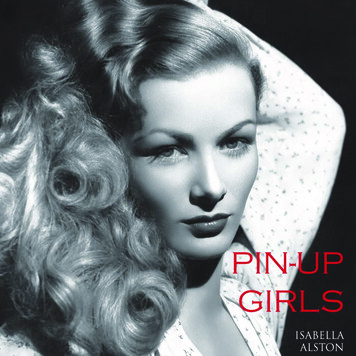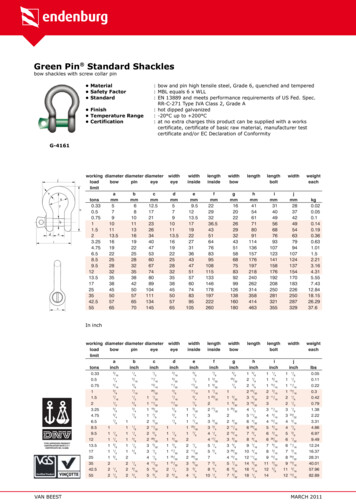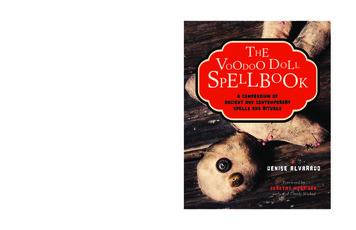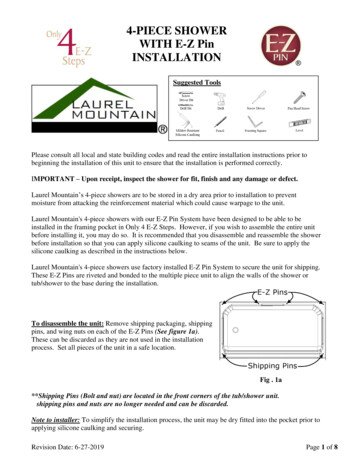
Transcription
Pin-up Girls
Published by TAJ Books International LLC 20145501 Kincross LaneCharlotte, North Carolina, ght 2014 TAJ Books International LLCAll rights reserved. No part of this publication may be reproduced, stored in aretrieval system, or transmitted in any form or by any means, electronic, mechanical,photocopying, recording, or otherwise, without the prior written permission of thePublisher and copyright holders.All notations of errors or omissions (author inquiries, permissions) concerning thecontent of this book should be addressed to info@tajbooks.com.The Publishers thank the Private Collection of Kevin Prochaska and Patrick Hitte, aswell as the unidentified families and estates of the artists whose work appears in thisbook. We have made our best efforts to contact the owners of copyrights for all artreproduced herein. Most publishers of calendar art no longer exist and, in most cases,the art has now fallen into public domain.ISBN 978-1-84406-264-5 Hardback978-1-62732-005-4Printed in China1 2 3 4 5 18 17 16 15 14
pin-up girlsI s a b e l l aA l s t o n
Pin-Up GirlsThe image most indelibly linked to theterm Pin-Up Girl is a busty, long-legged,beautiful woman posing in a revealing outfit,or even nude, on calendars, posters, and inmagazines during the World War II years.These images make up the quintessential andmost recognizable Pin-Up Girls, although theyare only representative of a specific era inpin-up history. The Pin-Up Girl has actuallybeen around since the late 19th century,when actresses and cabaret stars of theperiod used photographs of themselves as apromotional tactic. This format was somewhatrevolutionary because until that point, womenwere not expected to flaunt their image inpublic or in private. And if a woman did, shewas considered to be of an “unsavory” nature.The actresses and other female performerswho pioneered the pin-up were generallynot women of polite society, but they werepopular enough with their fans that they werenot publicly shamed. In this era of pin-up,women were particularly attuned to creatinga unique look in order for their image to beinstantly recognizable, able to garner them thenecessary attention to draw crowds and fanswhom they depended on to make their living.The late-19th-century pin-up was one ofthe first campaigns to promote a woman’ssexuality as publicity, and it worked. Thesewomen used their bodies—typically in avery tasteful manner—coupled with theirintelligence to get what they wanted. Theyknew what men desired and they used thatknowledge to their advantage. Perhaps,these early Pin-Up Girls were the earliestfrontrunner of the women’s liberationmovement.In the earliest era of pin-up, before the turnof the 20th century, the Gibson Girl, createdand drawn by Charles Dana Gibson, was aprecursor of the pin-up art that would becomeso popular in the 1940s and 1950s. The GibsonGirl emerged in the 1890s, an artful renderingthat combined a fragile, beautiful woman witha curvy figure, saved from promiscuity by arespectable demeanor. This was new territory.In the past, a voluptuous woman was almostalways depicted as lewd or immoral.The Gibson Girl was perceived as a“modern” woman. She was educated, relativelyindependent, and intelligent, and adheredto the accepted norms and mores of propersociety. Thus, she was accepted as pioneeringbut respectable, serving as an ideal to whichmany young women could aspire. Anothercritical element of the Gibson Girl mystiquecentered around the dominant position sheheld over men despite her apparent fragility.Gibson often illustrated her as looking downon the male sex. The Gibson Girl’s aloof senseof self-possession, combined with her beauty4
Memories of Olive1920, Alberto Vargas (1896–1982)OIive Thomas, who performed in the Ziegfeld Follies,commissioned by Florenz Ziegfeld5
and poise, created an irresistibly dynamicfemale, which never ceased to intrigue themale sex because they could never fullypossess her. The World War II and later Pin-UpGirls shared this reason for appeal. They werenot to be possessed, only viewed and lustedafter. As fashions changed and the femalesex was liberated politically as well as in thehome with the advent of the vacuum cleanerand the washing machine, the groundbreakingGibson Girl slowly dwindled from popularculture but was never forgotten. She was thefirst definitive sex icon in America and laidthe ground rules for what future generationsof American men and women understood to bethe basis of feminine beauty.Actresses and burlesque dancers in theearly 20th century used photography ofthemselves in provocative poses as a means ofself-promotion. Some of the most well-knownwomen in this category include the silentscreen star Clara Bow and the exotic dancerJosephine Baker.Raphael Kirchner, a French artist, took theGibson Girl a step further in his drawings ofwomen, primarily produced during the era ofWorld War I. Most were in postcard format.Kirchner is considered by some as the father ofpin-up, inspiring Alberto Vargas in his wellkown work 30 years later. Paul Chabas, alsoFrench, painted numerous nudes and addedsubstantially to the earliest body of pin-up art.But pin-up art was not the sole orbit of men.Mabel Rollins Harris created soft pastels ofnudes from the late 1920s and into the 1930s.Much of her pin-up work illustrated calendars.The notorious Pin-Up Girl, scantily clad,the subject of a photo or artwork specificallydesigned to be titillating to the male gender,did not fully develop until the early 1940s.The pin-up genre ran the gambit, both in artand photography, from simply the image ofa glamorous and beautiful woman to whatwas considered quite risqué—total nudity.Many Pin-Up Girls would make a mark forthemselves later as models or actresses, butthe launching pad of their careers was agrowing market for these “cheesecake” images.Actresses such as Marlene Dietrich, CydCharisse, Betty Grable, and Sophia Loren arejust a handful of examples.The increasing consumer demand forthe pin-up came first and foremost from theAmerican military as soldiers were deployed indroves to Europe and later to the Pacific. Thesesoldiers and sailors, mostly new recruits, hadto leave behind wives and girlfriends to facethe devastating conditions of war in whichthey lived in constant fear for their lives.The unknowns and uncertainties America’sfighting men dealt with daily were difficultto escape. The pin-ups, however, offered awelcome distraction if only for a few dreamyminutes. The photos, usually of the hottest6
movie stars of the day such as Betty Grableand Rita Hayworth, and drawings of PinUp Girls represented what waited for themat home after the war was won and over. Inthe midst of a dark and dismal present, thefuture was lit by the warm come-hither smileof a sexy lady waiting on the other side of ateeming sea.Bruno Bernard, who worked as Bruno ofHollywood, captured a wide array of pin-upposes with his camera in the 1940s and 1950s.He fled to the United States from Germany in1937 at the age of 26. He had served as thegeneral secretary of the Jewish undergroundmovement and his life was under threat. In1934, he had earned a doctorate in criminallaw at Kiel University and he did postgraduate work at the University of Berkeley.Put the pull of the arts and photographywas very strong. This is where he made hisultimate mark. In the early 1960s he returnedto his hometown of Berlin where he began acareer as a photojournalist.One of the first widely acclaimed pin-upartists was Alberto Vargas, a Peruvian-bornpainter, who found fame in the United States.His original works were less scandalous thanhis later works. After Vargas was hired byEsquire magazine in the 1940s specifically tocreate pin-up art for overseas soldiers, Vargassexed up his images. One of his signaturetouches was to draw women in scantily cladmilitary uniforms. He is often credited withpioneering the concept of the centerfold.At Esquire, Vargas dropped the “s” from hisname and immediately devised the Varga Girlcalendar, which made his reputation. Vargasleft Esquire in 1946, working on his own,even creating his own calendar, but under hisreal name, Vargas. In 1960, he joined Playboy,recruited by Hugh Hefner, to be the magazine’sprimary artist.But Vargas’ contemporary, George Petty,perhaps garnered more fame for his so-calledPetty Girls, which were often reproduced todecorate the front of fighter planes. Vargaswas hired by Esquire to replace Petty aftera dispute over Petty’s salary. Petty’s uniqueartistic style was less realistic than that ofVargas, and his girls were drawn out ofproportion; he would intentionally elongatetheir legs and reduce the size of their head.In many ways, Petty’s style resembles theproportions of the Barbie doll, which is sooften critiqued for it’s unrealistic and idealizedrepresentation of the female body.During this period, the popular pin-upcalendar made its debut. Gillette (aka Gil)Elvgren was the Louis F. Dow CalendarCompany’s star artist. His work would gracesome of the first pin-up calendars to beshipped overseas to American soldiers. In1944, Elvgren left Dow to join Brown &Bigelow, one of the premier calendar and7
print companes. Elvgren would continue towork for the company until 1972. Some of hismost well-known works were produced duringhis employment there. He was extremelysuccessful in the broader field of commercialart, producing works for Coca-Cola, GeneralElectric, and Sealy Mattress Companythroughout his career. Other artists thatproduced pin-up art for calendars in the 1950swere Ernest Chiriaka and Al Moore.In post-World War II America the boom inthe pin-up industry continued as the soldiersand sailors returned home still harboring anappetite for pin-up art. Additionally, war-timerestrictions on materials such as nylon werelifted. As a result, lingerie could be madeskimpier and sexier and was quickly adaptedinto the pin-up genre. During these years,the female body came out of the closet, soto speak, albeit under a veil of good, oldfashioned American morals. The Pin-Up Girlswere often depicted as vulnerable femaleswho were taken by surprise in their state ofundress or caught in a moment when theywere unintentionally revealing. This tacticadded a voyeuristic quality to the images,enhanced by the fact that they were portrayedas good, wholesome girls who would neverknowingly show what in polite society shouldstay under wraps. In contrast to today whena woman’s flaunting, dressed or not, of hersexuality is widely accepted by the majorityof the population, society of the 1940s and1950s had yet to experience the sexualliberation of the 1960s and 1970s. Therein laythe unmistakable allure of the Pin-Up Girl: awoman’s nude or semi-nude body was a raresight to behold.Marilyn Monroe is probably the mostfamous female in American pop culture,and her rise to fame began in the pin-upindustry. When Marilyn was 16, the productof several foster homes and an emotionallyunstable mother, she married Jim Dougherty,who would soon ship out to the Pacific as aMerchant Marine in World War II. While Jimwas gone Marilyn moved in with her motherin-law and began work at a factory thatmade parachutes and airplane parts. Whileshe was employed here, a photographer forYank magazine, on a mission to take moraleboosting photographs of young Americanwomen back home helping out the troops,discovered Marilyn, then called Norma Jean.The photographer encouraged Marilyn to signwith a local modeling agency. Her appearanceon a number of magazine covers garnered theattention of an executive at 20th Century Fox,who ultimately signed her to a seven-yearcontract.Marilyn’s career only took off in 1951,however, after a scandal emerged around somenude pin-up photographs she had posed for in1949. A couple of these nudies had featured8
in popular pin-up calendars, and she wasrecognized. The studio was concerned aboutthe potentially negative fallout, but Marilynadmitted the obvious and explained that shehad agreed to the shoot because she neededmoney for rent. Marilyn’s gamble worked,and what could have easily been interpretedas cheap behavior, destroying her fledglingcareer, was sympathetically viewed as theplight of any young Hollywood actress.The sudden spotlight on Marilyn rapidlyexpanded the public’s awareness of her. In1952, she graced the cover of TIME magazinewith the headline “The Talk of Hollywood.”One of four films released that year wasNiagara, arguably the film that launched hermovie career. In it, she plays a femme fatalewho schemes to murder her husband. Thegreatest attention from critics was spent notingher overt sexuality in the role, rather thanher acting ability. This film also establishedthe “look” that would forever be associatedwith her: platinum blonde hair, pouty lips,tight dresses, and lots of cleavage. She was aliving, breathing Pin-Up Girl. Marilyn’s pin-upphotos, which provided her the spotlight sheso needed to acheve her big break, may havebeen a double-edged sword, portraying her asthe sexy blonde bombshell, a role from whichshe could not break away.Playboy magazine, a natural follow-onto pin-up art, was founded in 1953 by HughHefner. Hefner put Marilyn Monroe on thecover of the first issue as well as in thecenterfold. It was a brilliant move because thecenterfold photo was the calendar photo thathad brought Marilyn notoriety and greatlyhelped popularize the magazine. The Playboybunny logo personified Hef’s image of theperfect Playboy girl as being playful, bouncy,innocent, cute, and uncomplicated. For hismagazine, Hefner always sought the girl-nextdoor who was simultaneously accessible, yetinaccesible. This is the same characteristic thatexemplified its forerunner, the very popularpin-up image.On the opposite end of the pin-up spectrumis the infamous Bettie Page, often referredto as the Queen of Pin-Up. Bettie’s parentsdivorced when she was about five years old.She claimed that her fat
The notorious Pin-Up Girl, scantily clad, the subject of a photo or artwork specifically designed to be titillating to the male gender, did not fully develop until the early 1940s. The pin-up genre ran the gambit, both in art and photography, from simply the image of a glamorous and beautiful woman to what was considered quite risqué—total nudity. Many Pin-Up Girls would make a mark for











